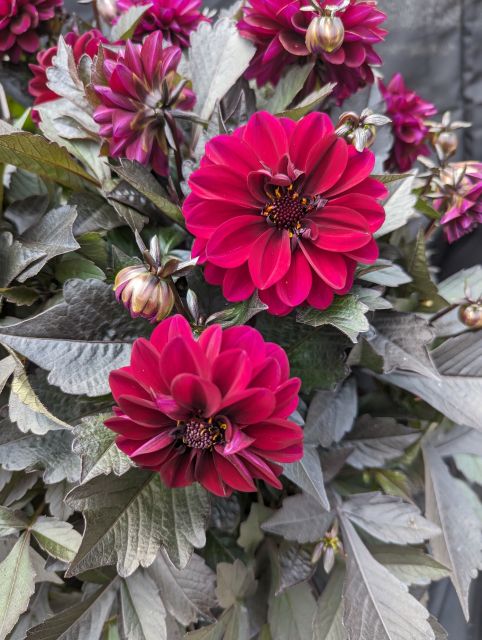Why the Future of Floriculture Field Trials Looks Bright

The trial garden at The Ohio State University receives visitors from Cultivate every July. Photo: Kathy Watson
Trials put new varieties to the test. If a new cultivar claims to be drought-tolerant, trials make breeders walk the walk, not just talk the talk. If a petunia is supposed to bounce back after it rains, trial managers will leave it in the rain to wait and see what happens. Without these tests of durability, breeders would not get the feedback they need.
Trial managers are plant geeks just as much as the next person, but they are there to collect the data. After a 31-year career (and counting) in horticulture, Pamela Bennett, Professor and Extension Educator at The Ohio State University, says the future of floriculture is bright.
“I think the future of floriculture is unlimited,” she says. “COVID-19 brought out the fact that everybody returned to gardening while they stayed home. Look at the houseplant craze — who would have thought? In the 1970s, houseplants were huge. Millennials have brought back the houseplant craze. It’s incredible to see what they’re willing to pay for.”
Emily Wildt, Regional Sales and Trial Garden Director at Raker-Roberta’s Young Plants, also references the next generation of gardeners. She says they are moving toward container gardens and baskets rather than bedding plants.
“We’re moving away from the generation that got down on their knees and planted luxurious beds and tended to their gardens. That generation is at the age where they can no longer do that,” Wildt says. “As we look at millennials and Gen Z, they want instant gratification. They live in apartments and townhomes and don’t have a yard to do things like that.”

One of the biggest challenges at Raker-Roberta’s trials is keeping deer away from the varieties. Photo: Raker-Roberta’s Young Plants
Kristi Challender, Trial Garden Operations Manager at Raker-Roberta’s, says consumers want to bring the outdoors indoors. In addition to houseplants, this is where herbs, mini peppers, and mini tomatoes come in handy.
Chad Miller, Trial Gardens Director for Colorado State University, says CSU has a public trial garden, so many consumers come to visit. One thing visitors are looking for in landscape plants are those that are drought-tolerant. The trial garden beds are organized into high, medium, and low irrigation rates, to assist consumers in better understanding plant water needs.
“As I think of what’s coming down the pike, I think of what’s drought tolerant,” he says. “There’s a concern of what our options will be for irrigating in the landscape.” He also anticipates continued development of plants that are floriferous and have eye-catching and attractive patterns.

MixMasters Lucky Charm (Ball FloraPlant) Photo: CSU
What’s Trending at Trials?
Dan Gerace, Production Manager at Welby Gardens, says breeders have been working on improving their series. When new products come to market, there may be a collection of flowers, but one particular color performs better than the others. Gerace says breeders have noticed this inconsistency, and are working to make series uniform. Growers prefer that all cultivars in a series flower at the same time and have the same flower power, and the only difference is the color or pattern.
Welby Gardens gives out colored poker chips for visitors to identify their favorite plants. Breeders and brokers use blue chips, retailers use red chips, and landscapers and growers use white chips. Gerace says it is interesting to see how different groups rate the same plants.
“The breeders are looking for a new species or something that hasn’t been out in the trade before, such as a dark-yellow petunia (prior to the release of ‘Bee’s Knees’ from Ball FloraPlant),” he says. “Garden centers like novelty things with flashy patterns, while landscapers and growers lean toward items with big volume potential.”

Dahlia ‘City Lights Purple’ (Selecta One) Photo: Welby Gardens
Rachel Gooder, Trial Manager at Plantpeddler, has noticed that there is a high demand for multiliners, which are commonly used with combination pots or hanging baskets. One liner is comprised of three items, so growers do not have to plant each one.
“We rely on them all the time because it’s so much easier,” Gooder says. “You need to have five people on a planting line to plant a combination basket. Nobody has the labor to do that. With a multiliner, you pop one liner out with three items in it and you drop it in the basket.”
It’s also helpful to growers so they can buy the liners as a pack, without having to research which varieties would pair well together.
“If you put together the wrong mix of calibrachoa and petunia, that crop is inferior product,” Gooder says. “Multiliners are great for a lot of greenhouses because they don’t have to do the research. You trust the genetics companies to put the right items together.”

Calibrachoa ‘Chameleon Frozen Ice’ (Westhoff) Photo: Plantpeddler
How Trials Have Evolved
Throughout her 40 years at JC Raulston Arboretum at North Carolina State University, Bedding Plant Trials Coordinator Bernadette Clark has noticed that the way the industry views plants has changed. Genera used to be categorized as sun or shade plants, for example.
“There’s been a shift from what we were always told, which is that everything had a place. We pushed through those boundaries by planting impatiens and begonias in the sun,” Clark says. “When I was in high school in the 1970s, houseplants were only in the house. Now they have shifted outside. Coleus plants used to be in the house, now they’re outside. We are bleeding that line.”
Bennett says she used to work in a perennial greenhouse. Perennials first came to Ohio in the early 1980s. They were available in 3-inch pots and did not bloom the first year.
“We got the perennials in April and there were just a few things in bloom. When customers asked what was available, I avoided the perennial house. There was nothing to sell but foliage and no flowers in that greenhouse,” she says. “Fast forward to today and growers have that technology with perennials that bloom first year. That’s a huge change that I’ve seen, and it will only keep getting better for growers.”
To describe the trial garden at Raker-Roberta’s, Wildt says “We decided we either had to go big or go home.” They treat it like a home gardener should treat their plants, with fertilizer and irrigation.

Petunia ‘Supertunia Mini Vista Yellow’ (Proven Winners) Photo: Bernadette Clark
“When a breeder comes in and says, ‘This is deer-resistant,’ we say, ‘OK, put your money where your mouth is. Put it in our trials and we will tell you if our deer like it or not,’” she says.
Wildt says Raker-Roberta’s uses data collection software to post weekly trial results on its website, showcasing information such as height and width of the plant. In addition to collecting data, she says there will be an increased focus on using the trial garden as a sales and marketing tool.
There are many benefits to trials, for the breeders, growers, retailers, and consumers. But for universities, Bennett points out that the biggest challenge is funding trials.
“We charge an entry fee from companies, but that doesn’t cover a technician. Fortunately, OSU is supporting the trials. It’s also heavily supported by volunteers,” Bennett says. “The organization hosting the trials tends to have to put in additional funding to do it. We have to pay for greenhouse space, so the income we get from the trials does not cover our expenses. But we feel it’s very valuable.”
Many trials are still going strong across the country, and leaders agree that it is critical to continue to support trials to advance the floriculture industry.









